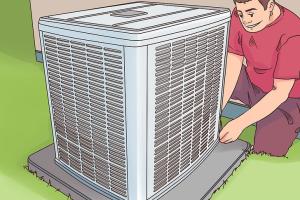Step-by-Step Guide: How to Add Freon to Your AC Unit Safely and Effectively

-
Quick Links:
- Introduction
- Understanding Freon and Its Role in AC Units
- Signs Your AC Unit Needs Freon
- Safety Precautions
- Tools Required
- Step-by-Step Guide to Adding Freon
- Case Studies and Examples
- Cost Analysis of Adding Freon
- Expert Insights
- FAQs
Introduction
Air conditioning units are essential appliances that provide comfort during hot months. However, like any mechanical system, they require maintenance, including the addition of refrigerants like Freon. This guide will help you understand how to add Freon to your AC unit safely and effectively.
Understanding Freon and Its Role in AC Units
Freon is a brand name for a group of chemicals used as refrigerants in cooling systems. The most common types of Freon used in residential air conditioning systems are R-22 and R-410A. Understanding how these refrigerants work can help you maintain your system better.
The Role of Freon
Freon circulates through the AC system, absorbing heat from the indoor air and releasing it outside. When the level of Freon is low, the system cannot cool effectively, leading to higher energy consumption and potential system damage.
Signs Your AC Unit Needs Freon
- Inadequate cooling despite setting the thermostat lower.
- Ice buildup on the evaporator coils.
- Hissing or bubbling sounds from the AC unit.
- Higher energy bills without a change in usage.
Safety Precautions
Before attempting to add Freon to your AC unit, it’s essential to take some safety precautions:
- Wear protective gear, including gloves and goggles.
- Make sure the AC unit is turned off before beginning any work.
- Ensure proper ventilation in the area where you will be working.
Tools Required
Gathering the right tools will ensure a smooth process. Here’s a list of what you’ll need:
- Refrigerant gauge set
- Freon (R-22 or R-410A, depending on your system)
- Wrench set
- Thermometer
- Safety gloves and goggles
Step-by-Step Guide to Adding Freon
Step 1: Identify the Service Port
Locate the low-pressure service port on your AC unit, typically found on the larger copper line leading to the compressor.
Step 2: Connect the Refrigerant Gauge
Attach the blue gauge hose to the low-pressure port. Ensure the connection is tight to avoid leaks.
Step 3: Check the Pressure
Turn on the AC unit and check the pressure readings on the gauge. This will help you determine how much Freon is needed.
Step 4: Add Freon
Connect the canister of Freon to the red gauge hose and open the valve slowly. Monitor the gauge to avoid overfilling.
Step 5: Monitor System Performance
After adding Freon, check the system’s performance. Ensure that the air blowing from the vents is cool and that there are no unusual sounds.
Case Studies and Examples
Consider a homeowner in Florida whose AC unit was struggling to cool their home. After checking the Freon levels, they discovered it was low and recharged it using this guide. The result was a significant decrease in energy bills and a comfortable living environment.
Cost Analysis of Adding Freon
The cost of adding Freon can vary based on the type of refrigerant and the service fees of HVAC professionals. On average, homeowners may spend between $150 and $400 to refill the refrigerant in their system.
Expert Insights
Experts recommend regularly checking your AC unit's refrigerant levels at the beginning of each summer season to prevent issues before they arise.
FAQs
1. How do I know if my AC unit needs Freon?
Look for signs like inadequate cooling, ice buildup, or unusual sounds.
2. Can I add Freon myself?
Yes, but ensure you follow safety precautions and understand the process.
3. Is it illegal to add Freon to an AC unit?
It is not illegal for homeowners, but it is regulated; you must follow local laws regarding refrigerants.
4. How often should I check my Freon levels?
Check at the start of each cooling season or if you notice performance issues.
5. What happens if I overfill Freon?
Overfilling can lead to system inefficiency and potential damage.
6. How long does Freon last in an AC unit?
Freon should last for years as long as there are no leaks in the system.
7. What should I do if my AC unit is leaking Freon?
Contact a professional HVAC technician immediately to repair the leak.
8. Can low Freon levels cause a compressor to fail?
Yes, low Freon can put extra strain on the compressor, leading to failure.
9. What are the environmental effects of Freon?
Freon can contribute to ozone depletion; thus, proper handling and disposal are crucial.
10. Are there alternatives to Freon?
Yes, options like R-410A are more environmentally friendly and commonly used today.
Random Reads
- How to record whatsapp calls iphone ipad
- Save web page as pdf
- Secure your documents password protect word
- How to paint fiberglass
- How to paint faux leather
- How to paint a door frame
- How to measure stairs for carpet
- How to merge layers in photoshop
- Unlocking skyscrapers simcity 4
- Unlocking world 4 super mario bros ds